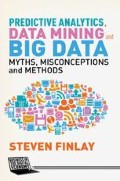Abstract
Predictive models come in all shapes and sizes. There are dozens, if not hundreds, of different methods that can be used to create a model, and more are being developed all the time. However, there are relatively few types of predictive models. The most common ones are:
Access this chapter
Tax calculation will be finalised at checkout
Purchases are for personal use only
Preview
Unable to display preview. Download preview PDF.
Notes
Lovie, A. and Lovie, P. (1986). The Flat Maximum Effect and Linear Scoring Models for Prediction, journal of Forecasting 5(3): 159–68.
Kass, G. V. (1980). An Exploratory Technique for Investigating Large Quantities of Categorical Data. Applied Statistics 29(2): 119–127.
Rumelhart, D. E., Hinton, G. E. and Williams, R. J. (1986). Learning Representations by Back-Propagating Errors. Nature 323(6088): 533–6.
In credit scoring, the most widely cited research study of the predictive accuracy of different methods, and which finds very little difference between them, is: Baesens, B., Gestel, T. V., Viaene, S., Stepanova, M., Suykens, J. and Vanthienen, J. (2003a). Benchmarking State-of-the-Art Classification Algorithms for Credit Scoring, journal of the Operational Research Society 54(5): 627–35.
Hand, D.J. (2005). Good Practice in Retail Credit Scorecard Assessment. yourno of the Operational Research Society 56(9): 1109–17.
Breiman, L. (2001). Random Forests. M achine Learning 45: 5–32.
Schapire, R. (1990). The Strength of Weak Learnability. journal of Machine Learning 5:197–227.
Copyright information
© 2014 Steven Finlay
About this chapter
Cite this chapter
Finlay, S. (2014). Types of Predictive Models. In: Predictive Analytics, Data Mining and Big Data. Business in the Digital Economy. Palgrave Macmillan, London. https://doi.org/10.1057/9781137379283_6
Download citation
DOI: https://doi.org/10.1057/9781137379283_6
Publisher Name: Palgrave Macmillan, London
Print ISBN: 978-1-349-47868-2
Online ISBN: 978-1-137-37928-3
eBook Packages: Palgrave Business & Management CollectionBusiness and Management (R0)

